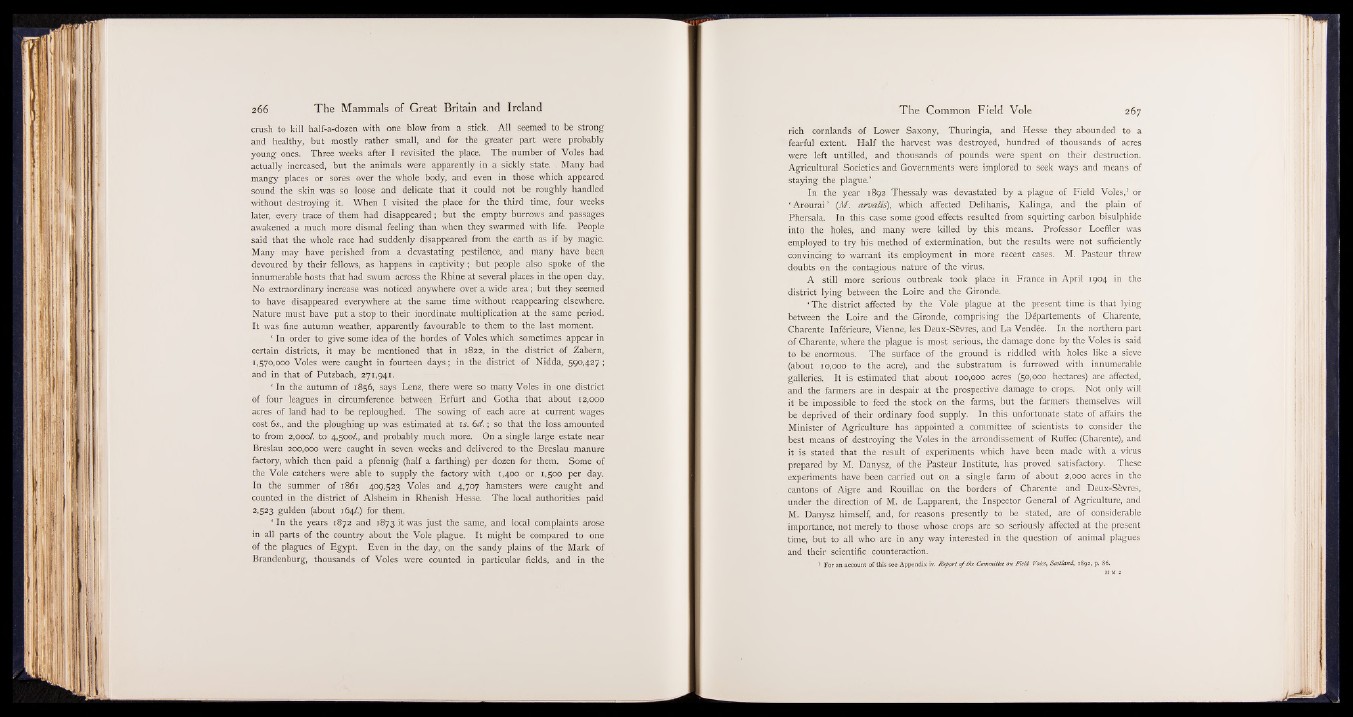
crush to kill half-a-dozen with one blow from a stick. All seemed to be strong
and healthy, but mostly rather small, and for the greater part were probably
young ones. Three weeks after I revisited the place. The number of Voles had
actually increased, but the animals were apparently in a sickly state. Many had
mangy places or sores over the whole body, and even in those which appeared
sound the skin was so loose and delicate that it could not be roughly handled
without destroying it. When I visited the place for the third time, four weeks
later, every trace of them had disappeared ; but the empty burrows and passages
awakened a much more dismal feeling than when they swarmed with life. People
said that the whole race had suddenly disappeared from the earth as if by magic.
Many may have perished from a devastating pestilence, and many have been
devoured by their fellows, as happens in captivity; but people also spoke of the
innumerable hosts that had swum across the Rhine at several places in the open day.
No extraordinary increase was noticed anywhere over a wide area; but they seemed
to have disappeared everywhere at the same time without reappearing elsewhere.
Nature must have put a stop to their inordinate multiplication at the same period.
It was fine autumn weather, apparently favourable to them to the last moment.
‘ In order to give some idea of the hordes of Voles which sometimes appear in
certain districts, it may be mentioned that in 1822, in the district of Zabern,
1,570,000 Voles were caught in fourteen days; in the district of Nidda, 590,427 ;
and in that of Putzbach, 271,941.
‘ In the autumn of 1856, says Lenz, there were so many Voles in one district
of four leagues in circumference between Erfurt and Gotha that about 12,000
acres of land had to be reploughed. The sowing of each acre at current wages
cost 6s., and the ploughing up was estimated at 15. 6d. ; so that the loss amounted
to from 2,000/. to 4,500/., and probably much more. On a single large estate near
Breslau 200,000 were caught in seven weeks and delivered to the Breslau manure
factory, which then paid a pfennig (half a farthing) per dozen for them. Some of
the Vole catchers were able to supply the factory with 1,400 or 1,500 per day.
In the summer of 1861 409,523 Voles and 4,707 hamsters were caught and
counted in the district of Alsheim in Rhenish Hesse. The local authorities paid
2,523 gulden (about 164/.) for them.
‘ In the years 1872 and 1873 it was just the same, and local complaints arose
in all parts of the country about the Vole plague. It might be compared to one
of the plagues of Egypt. Even in the day, on the sandy plains of the Mark of
Brandenburg, thousands of Voles were counted in particular fields, and in the
rich cornlands of Lower Saxony, Thuringia, and Hesse they abounded to a
fearful extent. Half the harvest was destroyed, hundred of thousands of acres
were left untilled, and thousands of pounds were spent on their destruction.
Agricultural Societies and Governments were implored to seek ways and means of
staying the plague.’
In the year 1892 Thessaly was devastated by a plague of Field Voles,1 or
‘ Arourai ’ {M. a rvalis), which affected Delihanis, Kalinga, and the plain of
Phersala. In this case some good effects resulted from squirting carbon bisulphide
into the holes, and many were killed by this means. Professor Loeffler was
employed to try his method of extermination, but the results were not sufficiently
convincing to warrant its employment in more recent cases. M. Pasteur threw
doubts on the contagious nature of the virus.
A still more serious outbreak took place in France in April 1904 in the
district lying between the Loire and the Gironde.
‘ The district affected by the Vole plague at the present time is that lying
between the Loire and the Gironde, comprising the Départements of Charente,
Charente Inférieure, Vienne, les Deux-Sèvres, and La Vendée. In the northern part
of Charente, where the plague is most serious, the damage done by the Voles is said
to be enormous. The surface of the ground is riddled with holes like a sieve
(about 10,000 to the acre), and the substratum is furrowed with innumerable
galleries. It is estimated that about 100,000 acres (50,000 hectares) are affected,
and the farmers are in despair at the prospective damage to crops. Not only will
it be impossible to feed the stock on the farms, but the farmers themselves will
be deprived of their ordinary food supply. In this unfortunate state of affairs the
Minister of Agriculture has appointed a committee of scientists to consider the
best means of destroying the Voles in the arrondissement of Ruffec (Charente), and
it is stated that the result of experiments which have been made with a virus
prepared by M. Danysz, of the Pasteur Institute, has proved satisfactory. These
experiments have been carried out on a single farm of about 2,000 acres in the
cantons of Aigre and Rouillac on the borders of Charente and Deux-Sèvres,
under the direction of M. de Lapparent, the Inspector General of Agriculture, and
M. Danysz himself, and, for reasons presently to be stated, are of considerable
importance, not merely to those whose crops are so seriously affected at the present
time, but to all who are in any way interested in the question of animal plagues
and their scientific counteraction.
1 For an account of this see Appendix iv. Report o f the Committee on F ield Voles, Scotland, 1892, p. 86.